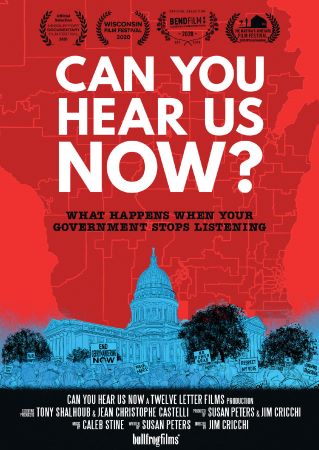
Can You Hear Us Now? 2021
Distributed by Bullfrog Films, PO Box 149, Oley, PA 19547; 800-543-FROG (3764)
Produced by Jim Cricchi and Susan Peters
Directed by Jim Cricchi
Streaming, 87 mins
College
Democracy; Political Science; Politics
Date Entered: 05/17/2022
Reviewed by Sam Lohmann, Reference Coordinator and Information Services Librarian, Washington State University VancouverCan You Hear Us Now? depicts the effects of Republican-led gerrymandering and voter-suppression efforts in Wisconsin over the past decade, focusing on two unsuccessful Democratic campaigns for State Assembly seats in 2018. While the film may be read as a microcosm of minoritarian Republican ascendancy and successful voter suppression across the United States, Wisconsin under Republican governor Scott Walker is notable for several reasons. Although the majority of votes went to Democrats, Wisconsin delivered a supermajority to Republicans in the State Assembly in 2016, largely due to redistricting. The situation in Wisconsin received national attention in 2017 when the Supreme Court remanded the Gill vs. Whitford case to the lower courts and declined to rule on the issue of extreme partisan gerrymandering. Voter ID laws (combined with neglected transportation infrastructure, as the film points out) have also led to lower voter turnout in Wisconsin, especially in traditionally Democratic districts. Wisconsin has longstanding left and progressive traditions and has been perceived as a political battleground at least since Walker’s attacks on public-sector unions in 2011, which led to massive protests.
The primary strength of the film is its intimate portraits of two state-level political campaigns, by Jennifer Estrada of Manitowoc and Rebecca Clarke of Sheboygan, both running for State Assembly as Democrats. It is unglamorous collective work carried on at kitchen tables, in small storefront offices, and from door to door, and the candidates acknowledge that there is little hope of success due to the Republican-drawn district lines. Candidates and volunteers are shown calling likely voters, cooking and cleaning for events, knocking on doors, and driving potential voters to the DMV to renew their state ID. Clarke notes that there is a need to run serious campaigns even with little hope of winning, in order to secure party support and motivate voters in future elections when district lines change. Estrada tells a more personal story and is by far the most interesting figure in the film. In the aftermath of deindustrialization, Estrada works “at least two jobs” (including roofing and agricultural work) and cares for two young children as a single parent while campaigning. Her husband, an undocumented immigrant, was deported to Mexico, and she clearly has a personal stake in opposing the state’s crackdown on undocumented immigrants, pointing out that low-paid immigrant workers produce enormous wealth for the state’s agricultural economy. She tells the horrific, and horrifically commonplace, story of her husband’s deportation in a voiceover. While the film often falls back on a cliché visual rhetoric of small-town white America, it offers a sharp depiction of what must be an exhausting routine of jobs, family life, and campaigning.
Can You Hear Us Now? gives an adequate account of the history, mechanisms, and effects of gerrymandering, voter ID laws, and other Republican policies such as cuts to education and attacks on public sector collective bargaining, many of which can be traced back to the American Legislative Exchange Council (ALEC) think tank. However, it says very little explicitly about why these struggles matter to voters or how Democratic success might impact ordinary people’s lives. It is disappointingly reticent about racial and class politics and leaves much unsaid about urban-suburban-rural divisions. While Republican policies are implicitly framed as an attack on poor and working-class people, the film does not show how Democratic success would counteract this attack. By focusing almost exclusively on electoral politics and procedural reform, the film enacts an unconvincing but depressingly familiar theory of social change. It suggests that if Republicans would only play by the rules, and Democratic voters would only vote a little harder, the ravages of neoliberal class-war (this reviewer’s term) would be reversed. Socioeconomic conditions are cause for vague gestures, rather than analysis, and provide a background for a partisan tug-of-war that seems curiously empty, even if the stakes are enormous in reality.
A different film might have followed the resurgence of labor organizing following the 2011 protests or looked in detail at how deindustrialization has impacted towns like Manitowoc and how people have responded. This film maintains a strong focus on electoral campaigns, and gives an unambitious but honest portrait of the frustrated, dispirited struggle within the limits of electoral progressivism in our time. The mood is highlighted in a fascinating way by Sheila Plotkin’s discussion of her project called “We the Irrelevant,” which drew on public records to document the degree to which constituents’ comments were ignored by the Republican-controlled State Assembly on a wide variety of issues. The film ends with the assembly’s “lame duck power-grab” legislation following Walker’s defeat in the gubernatorial race.
Awards:Newburyport Documentary Film Festival; Martha's Vineyard Film Festival; Wisconsin Film Festival; BendFilm Festival
Published and licensed under the Creative Commons Attribution 4.0 license. Anyone can use these reviews, so long as they comply with the terms of the license.